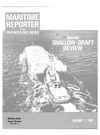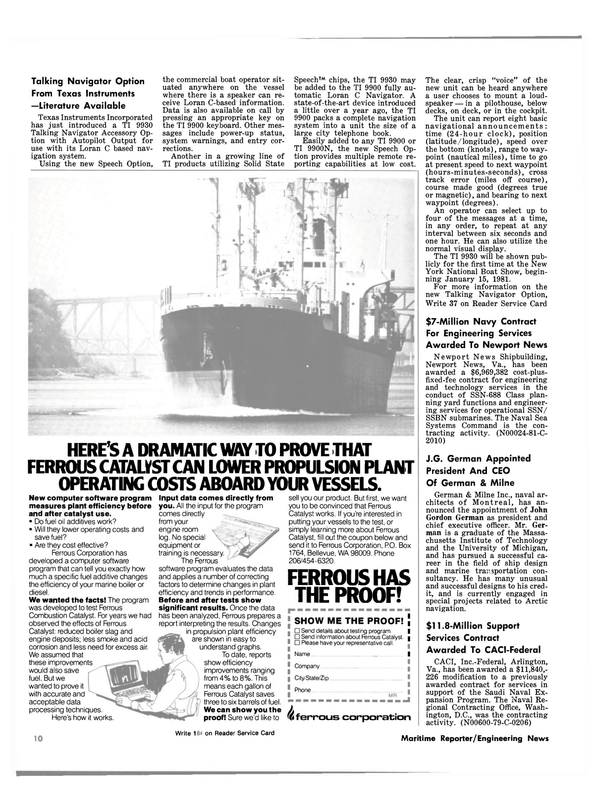
Combination Gas Tanker 'Hektor' Delivered By Moss Verft
The Moss, Norway, yard of Moss Rosenberg Verft A/S, a member of the Kvaerner Group, recently delivered the liquefied petroleum g a s / c h e m i c a l tanker Hektor to A/S Nordsjogas of Stavanger, Norway. The ship has a total cargo capacity of 24,000 cubic meters divided in three tanks. These are designed for carrying propane, butane, ammonia, vinyl chloride (VCM) as well as mixtures of propane and butane.
Two types of cargo can be carried simultaneously.
Hektor is built according to Det norske Veritas class + 1A1, Ice C, EO, Tanker for Liquefied Gas.
She is constructed in accordance with U.S. Coast Guard Rules and Regulations for Foreign-Flag Vessels, and also complies with IMCO Gas Code Regulation A 328 IX.
The ship has an overall length of 157.80 meters, beam of 24.40 meters, and depth of 16.00 meters (517.7 by 80 by 52.5 feet). At maximum draft of 10.70 meters (35.1 feet), she has a deadweight of 20,000 tons; gross tonnage is 15,819.
The ship is built with a single deck and without forecastle and poop. All accommodations and the engine room are arranged aft.
Seven watertight bulkheads subdivide the ship, which is built with double bottom and single shell.
The shell, main deck, and inner bottom in the cargo area are fabricated of steel meeting the requirements of a secondary barrier for cargo containment.
Hektor has three independent, self-supporting cargo tanks of prismatic shape. They are designed for carrying fully cooled LPG, NHs, and VCM operating with a slight overpressure; lowest permissible temperature is minus 48 C. The tanks are built as a welded structure of plates of low-temperature steel, and insulated on the outside with polyurethane.
All pipe connections to the car- go tanks are connected to the tank dome. Discharging is carried out in about 10 hours by six deepwell pumps, two in each tank.
Crossovers connect the ship's loading /discharge lines with loading arm on shore. Boil-off from the cargo is fed to the onboard reliquefaction plant, which consists of three two-stage units that reliquefy the gas and return it to the cargo tanks.
Main propulsion is by a Horton/ Sulzer 6RND76M diesel with maximum continuous rating of 14,400 bhp at 122 rpm. Trial speed was 17.5 knots at a draft of 9.2 meters (about 30.2 feet). Two side thrusters are installed, one forward and one aft.
The ship is equipped with a gas detector and an inert gas plant; both are of Moss design and were fabricated by Moss Verft. Navigation equipment includes two radars, Decca Navigator, radio direction finder, gyrocompass system, autopilot, echosounder, and magnetic compasses.
Read Combination Gas Tanker 'Hektor' Delivered By Moss Verft in Pdf, Flash or Html5 edition of January 1981 Maritime Reporter
Other stories from January 1981 issue
Content
- Zelvin Levine Appointed Advanced Ship Operations Director At MarAd page: 4
- $8.6-Million Contract For Frigate Overhaul Awarded By Navy To BIW page: 6
- Phillips Appointed Gulf Coast General Manager For Designers & Planners page: 6
- Australia Fights Oil Spills With MARCO Class I Skimmers page: 6
- James H. Cottrell Joins Ogden Corporation As Vice President page: 7
- Guralnick Associates Awarded Design Contract By MSC-Pacific page: 7
- $53.2-Million Contract For Supply Boats Signed By Halter page: 7
- Riverway Shipyard Co. Completes Construction Of 120-Foot Tank Barge page: 7
- Combination Gas Tanker 'Hektor' Delivered By Moss Verft page: 8
- Diesel Shipbuilding Delivers Steel Harbor Tug To Ecuador page: 8
- Twin Towing/Supply Vessels Delivered By Quality Shipyards page: 8
- Bulletin On New Fuel Oil Blending Unit Available From IMO page: 9
- Talking Navigator Option From Texas Instruments —Literature Available page: 10
- Australia Receives First Of Four Gas-Turbine-Powered FFGs From Todd Seattle page: 10
- SNAME Los Angeles Section Hears Paper On Noise Control page: 10
- Kockums Sells LNG Ship To West German Consortium page: 10
- New Service Station For Propellers Added At Curacao Drydock Yard page: 11
- Twin-Screw Supply Vessel Delivered By Bender Shipbuilding page: 12
- Three Executive Changes Announced By Ellicott Machine Corporation page: 12
- McDermott International Buys Pipelaying Barge For $85 Million page: 13
- OPS Forms New Marine Design Services Division Roy Thomas Named Director page: 13
- A Review OUTSTANDING U.S. SHALLOW DRAFT VESSELS OF 1980 page: 14
- RYSCO Delivers Another Tug/Supply Vessel To Billy Pugh Offshore page: 14
- APL And Port Of LA. Join To Develop New Container Terminal page: 14
- Electro-Nav To Furnish Electronics Parts And Service For Polish Ships page: 14
- RCA Adds Radiotelephone To Marine Equipment Line —Literature Available page: 16
- Fritz Named Supervisor Of Engineering Computer Operations At J.J. Henry page: 16
- Hitachi To Build Third Jackup Rig For Danish J.L Offshore Drilling page: 18
- J.E. Folsom Named Gulf Region Sales Manager For Hydranautics page: 18
- Simrad Introduces New Microcomputer-Controlled Loran C Navigator page: 19
- Tracor Marine Awarded $8-Million Contract By Rockwell International page: 20
- Joint SNAME/ASNE Meeting Hears Report On SPC Coating page: 20
- Bethlehem's Beaumont Yard Completes Jackup For Temple Drilling page: 21
- Bay Shipbuilding Launches Tank Barge For Hannah Marine page: 22
- Henschel Introduces New Ship's Bell Logger- Literature Available page: 22
- DeJong Designs Biggest Voith Schneider Tug Built In United States page: 23
- National Marine Gets Title XI Approval On $38.5-Million Orders page: 24
- Caterpillar Announces Two Improved Diesels —Free Brochure Available page: 26
- Dravo Corporation Seeking To Acquire Ryan-Walsh Companies page: 26
- MARCO Seattle Christens New North Pacific Fishing Vessel page: 26
- Halter Delivers Two Crewboats For Service Offshore Brazil page: 28
- New Color Brochure On Escher Wyss Props Available At No Cost page: 28
- MSC Will Charter Sun Transport's New Product Carrier 'New York Sun' page: 28
- Bergeron Enters New Product Line With Four Tank Barges page: 29
- Levingston To Build $45-Million Jackup Rig For Noble Drilling Corp page: 29
- Bulkfleet Marine Awards Maintenance System Contract To Stanwick page: 29
- Belcher Towing To Add Powerful Docking Tug To Its Miami Fleet page: 29
- Three New Management Appointments Made At Crowley Maritime page: 30
- Heavy-Lift Derrick Barge Can Lift Up To 400 Tons page: 32
- Ingalls Awarded Fourth Keyes Offshore Contract For Jackup Drilling Rig page: 32
- Jacksonville P.A. To Spend $25.5 Million To Expand Blount Island Facility page: 32
- Wheelock Maritime Ltd. Orders Two Bulkers From China Corporation page: 33
- Norwegian Firm Offers New Control Option For Ship-Handling System page: 33
- Technology Survey Of Major U.S. Shipyards page: 34
- Ingalls Shipbuilding Promotes Three To Vice Presdent Posts page: 34
- New Searchlight Announced By Phoenix Products- Literature Available page: 34
- McDermott Acquires Welding Equipment And Technology From Price page: 34
- McNab Announces Fuel Management System- Literature Available page: 34
- $7.7 Million Authorized For Improvements At Newport News Terminal page: 35
- Worthington Establishes Pump Specialty Shop For Replacement Parts page: 36
- A r e n d a l Y a r d Completes J a c k u p D r i l l i n g Rig For Swedish Owners page: 36
- SSB A n t e n n a I n t r o d u c ed By Phelps D o d g e - L i t e r a t u r e A v a i l a b le page: 37
- Fred Eisenbiegler Named To Board Of Trustees At Webb Institute page: 39
- New Offshore Mooring System Under Development In Scotland page: 39
- Clements Named Group VP At Tracor Components, Succeeding J.D. Hughes page: 41
- J.M. Wilson Named Vice President-Engineering At Philadelphia Resins page: 41
- Walbridge Reelected Chairman Of A I M V - Other Officers Named page: 42
- Steven Moodie To Retire As President And Director Of Interocean Shipping page: 42
- $180-Million Satellite Communications System Approved By INMARSAT page: 42
- Maencor Adds New Management Personnel page: 43
- Senermar Announce New Mini-Computer Version Of FORAN System page: 43
- Marland Licensed To Build And Market New Oil/Water Separator page: 43
- Rados International To Design Purse Seiners For Mexico page: 44
- Bay Shipbuilding Will Build Oceangoing Bulk Cargo Barge For Universal American page: 45
- Bergeron Launches 100th Vessel Built At Its Mississippi Facility page: 45
- General Ship Corporation Yard Is Purchased By Private Investors page: 45
- Promet Gets Orders From Sedco, Sun Contractors For Four Drilling Units page: 46
- Oceangoing Tank Barge Launched At FMC Yard page: 46
- Electric Boat Launches Attack Submarine 'Baltimore' page: 46
- Megasystems Building New $1.5-Million Center In Boca Raton, Florida page: 47
- WOMA Announces New Sales Brochure On Its Water-Blasting Equipment page: 47
- Re-engining Of Seatrain Ships Discussed At New York SNAME page: 48
- SNAME Chesapeake And MTS Washington Sections In Joint Meeting page: 48
- New Firm Will Provide Skilled Workers For Building & Repair Yards page: 49
- Skinner To Produce Steam Engines In New Larger Capacities page: 49
- $1,2-Million Navy Contract For Communications Buoy Awarded To Hazeltine page: 50
- New Ultrasonic Liquid Level Control System Introduced By Inventron page: 50
- New Watch Receiver Announced By DEBEG— Literature Available page: 50
- First Of Three Catug/Barge Units Christened At Avondale Yard page: 58
- SNAME Pacific Northwest Section Holds Meeting In Canada page: 58


